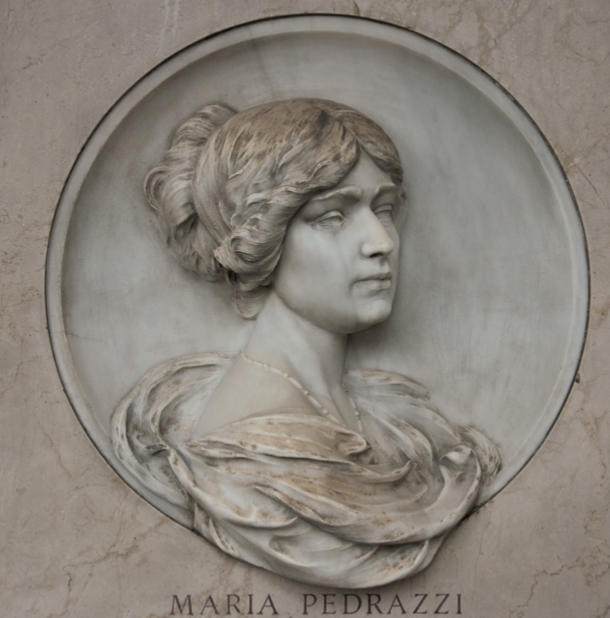Maria Pedrazzi, angel of gentle goodness, great and kind soul, unique daughter, fell asleep in Christ on October 14, 1918, at age 24, taken by a fierce disease, chosen among the stars of the art of music. She was a great pianist and singer. She wanted her artistic baptism in her hometown at the Community Theatre. Amneris in Aida marked her great triumph and her doom. The fierce disease referred to in the epigraph of her tomb in the Certosa di Bologna is none other than “Spanish flu,” the virus that caused the death of over 600 people in Bologna, between October 1918 and March 1919. The virus, which infected young people more than the elderly and women more than men, attacked the respiratory tract, caused severe fevers, joint pains, tachycardia, violent coughing with lethal pulmonary complications. In the month of October 1918 in Bologna, the number of deaths reached an alarmingly high level. Maria Pedrazzi, who had been a piano student in Bologna’s School of Music from 1903 to 1911, following in her mother Rosina Giovannoni Zacchi’s footsteps, had also studied singing under the guidance of Maestro Arrigoni. The Bolognese composer Ottorino Respighi dedicated to her a few lyrics. On the evening of October 6, 1918, due to an illness of the main singer who had sung in the Premiere of October 4, Maria Pedrazzi was asked to replace her and sing in the Aida. The following day the Resto del Carlino stated: “But the greatest interest of this second performance was the debut in the part of Amneris of Miss Maria Pedrazzi.

Bolognese have known for a long time this very young artist who has performed in several important concerts. They had admired her strong temperament, her beautiful voice, warm and colourful, her excellent schooling, her always very fine sense of art. The applause she received in the duet of the second act, and which rose to acclamation, in the first scenes of the last, are the sincere and undoubted reflection of the effectiveness and power of her art.” Unfortunately, on October 15, in the same page in which her obituary was published, the music critic of the Resto del Carlino dedicated a touching farewell to her, recalling the enthusiastic debut of a few days before and commented, “The beautiful smile of this young woman seemed to light up at the mirage of glory.” By an unbelievable and sad coincidence, the Bolognese newspaper of October 4 (the day of the premiere) reported the death of Adele Roessinger, a young and promising opera singer who had made a name for herself in Milan during the last few theatre seasons. The journalist pointed out that the young artist “on the eve of her wedding and due to a tragic fate joined her fiancé in the grave after a few hours.” Both died in Bari where Roessinger was to sing at the Petruzzelli theatre.




.png)